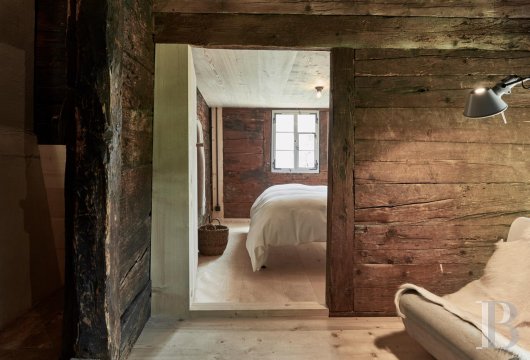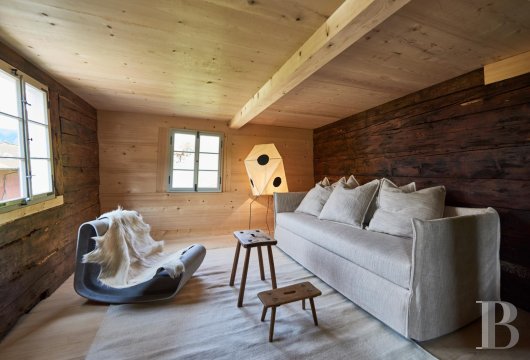Add to favorites
Log in to your personal space

If it were not for the lighter wood that suggests some recent maintenance, this chalet would immediately transport the imagination back to a rural and working Switzerland; a place characterised by herds, the ringing of cowbells, stored hay and the clamour of men at work. Inside, the renovations have masterfully balanced the preservation of the original structure and elements with the integration of necessary modern comforts. All without altering the "soul" of the property. On the edge of a hamlet surrounded by mountains and overlooking a lake, the location only adds to the charm and promises calm, exquisite stays.
Haus Tannen was built in 1341. Before the current owners handed the seven hundred-year-old residential building over to the Stiftung Ferien im Baudenkmal (a foundation that restores monuments for tourism purposes) in 2016, it had been unoccupied for many years and was in danger of collapsing. The renovations, which were completed in September 2017, gave the Tannen house a new lease of life. Thanks to the helpful cooperation of the former owners, the dedication to preserving historical monuments in the Canton of Schwyz and our foundation (Vacances au cœur du Patrimoine) we were able to save this historic wooden house from ruin.
Haus Tannen is a two-story log building made of spruce wood and built on a stone base. The multi-storey property employs a modular system which was an essential construction principle used in late medieval log buildings. With its stately, rectangular form, the house is part of the defining and identity-forming appearance of central Switzerland's cultural landscape. With the exception of the east dormer (which was added in the 19th century) both the exterior and the interior structure of the house have seen very few changes over the last 650 years. The upper floor is still in its original condition. The small door openings, the height of the doorsteps and the narrow skylights designed to prevent drafts evidence the time at which the property was built, almost seven centuries ago. Protection from harm and plagues was an ever-present concern in the Middle Ages. Even today, "Geisterbanndübel" (small wedge-shaped pieces of wood which were burned and pushed into the interstices and cracks in the walls) can be found in the living room, as well as traces of burn marks in the shape of small flames which were used to ward off the "Toggeli", an evil mythical character. The “Herrgottswinkel” domestic alter can still be made out opposite the door to the living room.
Haus Tannen is one of the oldest wooden buildings in the Canton of Schwyz and even in Europe. According to legend, the house was built in around 1290 in Riemenstalden, at the time the Swiss Confederation was founded. Some fifty years later it was moved to its present location as a moveable asset. Scientific research suggests that the former Haus Tannen also served as a hostel and inn for travellers making their way through the Urnerland towards the Gotthard. It was then used as a holiday home for several years, before a long period of abandonment during which it fell into a state of ruin and was very nearly lost for good. The works completed in September 2017 brought new lustre to the house. During the restoration, the original spatial structure was left untouched. Strict priority was given to the preservation of the building during this major refurbishment. The creaking floors, the lopsided walls, the black marks in the former smoking room and the old doors all evidence the time at which the property was built. The structure of the building has been preserved, the low ceilings (1.88 meters) and the floors dug over the centuries have been kept as they are. Old and new now come together perfectly in Haus Tannen which is equipped with a modern kitchen and bathroom and furnished with Swiss design classics.

Guests of Haus Tannen experience 700 years of Schwyz architectural history during their stay. Upon arrival, the guest relations manager takes them on a tour of the house during which they learn more about the history and architectural features of the monument. The manager also remains available throughout the stay should guests have any questions. Creaking floorboards, the smell of the ceramic stove and the magnificent view of the surrounding mountains and Lake Uri make a stay at Haus Tannen an unforgettable experience. The house is furnished with Swiss designer furniture and objects from regional manufacturers. The minimalist décor allows the architecture to take centre stage.

Haus Tannen is located in the Canton of Schwyz about half an hour's walk from Morschach, directly on the Swiss Path hiking trail, in the middle of an impressive alpine landscape with lively customs. Schwyz is the home of the Swiss army knife for example, which is famous all over the world. Explore natural wonders such as the karst mountain and alpine wilderness of Muotathal. Appreciate spectacular views from the Grand Mythen and the Rigi. Or go back in time during a visit to the "master of Schwyz accordions", the manufacturer of horn sleds or "Büchelhorn" (an alphorn in the shape of a trumpet). The village offers wonderful viewpoints and numerous hiking opportunities. The central location makes it the ideal starting point for mountain excursions on the Fronalpstock and boat trips from Brunnen on Lake Uri.
1250 € - 1715 € per week
The house can accommodate eight people. It consists of three bedrooms upstairs, a living room with a sofa bed, an equipped kitchen, a dining room, two bathrooms and a sauna. A cot is also available for babies. In order to preserve the historical structure of the building, no central heating system has been installed in the house. The "monument" building is heated using the restored ceramic stove located in the living room. In good weather, the outdoor seating area can be used. In the cellar, there is a small storehouse with homemade regional specialties that guests can help themselves to.
ref 204158

 A link to enter a new password has been sent to you by email.
A link to enter a new password has been sent to you by email.
By continuing your navigation, you accept the use of cookies to offer you services and offers adapted to your centers of interest and to measure the frequentation of our services. Learn more